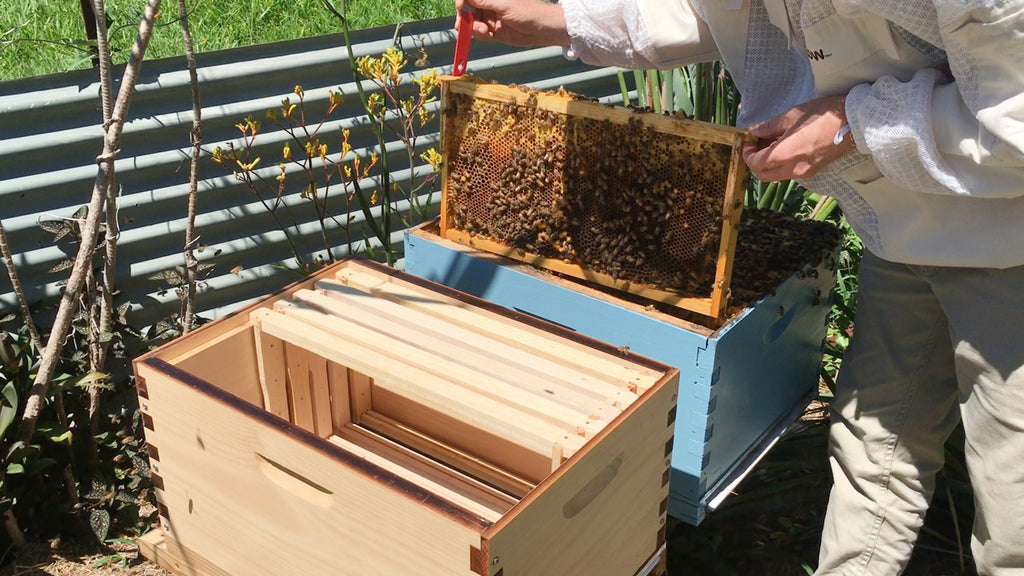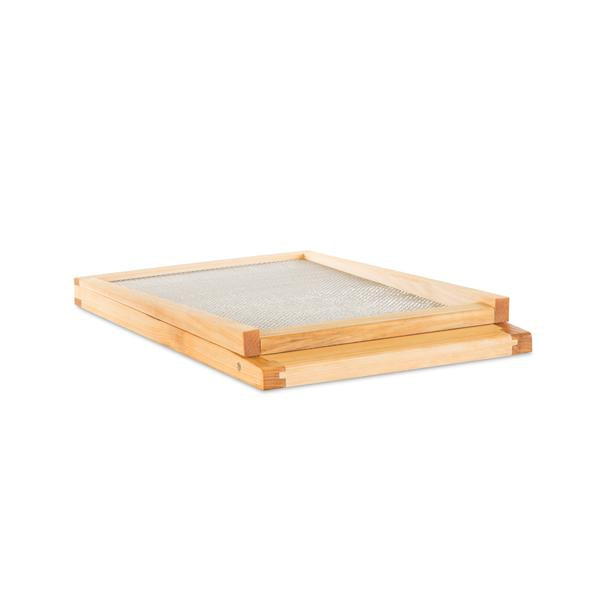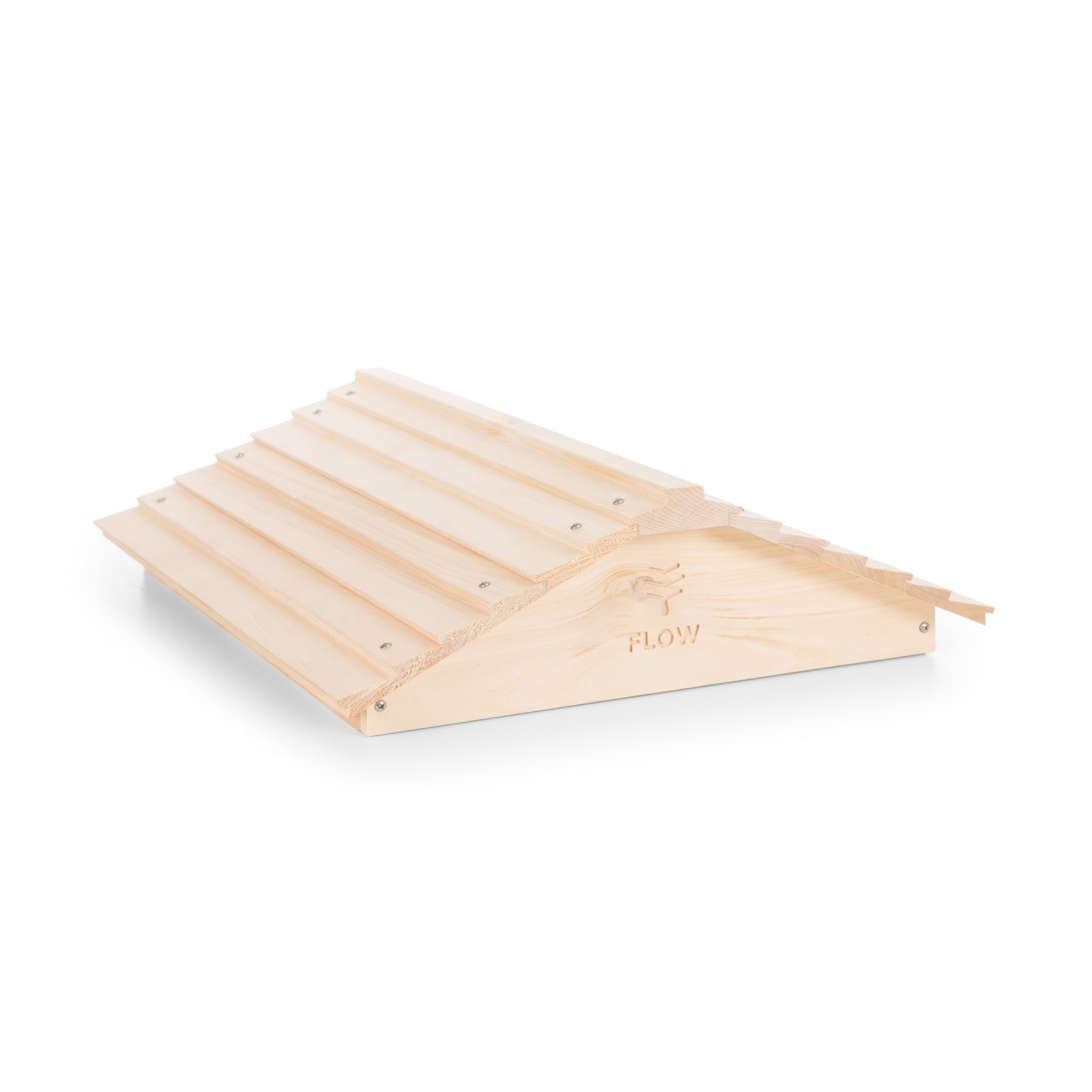Your Cart is Empty
Swarm Prevention
by Flow Hive 9 min read
Swarming is the honeybee colony’s natural means of reproducing itself. Bees usually swarm during spring or summer when lots of food is available. Beekeepers should recognise when their bees in their hives are preparing to swarm, or have already swarmed.
- What causes a beehive to swarm?
- Signs to look out for
- Know your queen cells
- Has your colony already swarmed?
- Types of swarms
- Is it okay to let your bees swarm?
- How to prevent swarming
- Is it possible to stop swarming without splitting?
- Should you remove swarm cells?
- Will a queen excluder prevent swarming?
- Swarm prevention summary

What causes a beehive to swarm?
Like almost all fauna and flora, honeybees have an urge to reproduce. If beekeepers don’t notice the signs and respond accordingly, honeybees will multiply naturally through swarming.
Swarming involves the queen and a percentage of the colony leaving the original hive, usually due to outgrowing their current space, to establish a new home elsewhere. It’s a great risk to the colony; doing so is a sign that they are healthy, well populated and have access to good amounts of nectar and pollen. Once colonies feel the urge to multiply, very little will stop them.
As with the majority of beekeeping, swarm mitigation is about understanding bee behaviour and attempting to assist them as best you can.
Signs to look out for
There are a number of signs your colony might be preparing to swarm. These are often the reasons that they are swarming in the first place!
Signs that a colony might swarm include:
- A very high population of bees in the hive.
- The whole width of the entrance is used by forager bees.
- All frames within the hive are fully drawn.
- Brood frames are full of resources (nectar, pollen, honey, capped and uncapped brood).
- High pollen flow in you area, but limited nectar availability.
- Bees are storing larger amounts of honey in and above the brood frames, and any other vacant space in the hive. This can lead to a colony becoming honey bound, which reduces the colony's brood rearing space.
- High drone population, plus evidence of capped drone cells or larvae. Drones are made in preparation to mate with a new queen. This also shows the colony is resource rich; they can afford to expend time and resources for the care of drones. If a colony begins to decline, drone bees are usually the first to go.
- Bees are bearding consistently, regardless of temperature, because there’s not enough room in the hive. Do note that after harvesting you may see a lot of bees out the front making room for other members of the colony to clean and prepare the wax.
Orientation flights can very easily be mistaken for swarming. The main difference is during orientation flights, lots of bees do figures of 8 increasing in size to understand where their home is. Think of it like establishing GPS coordinates.
It can be easy to confuse bees that are doing orientation flights with bees preparing to swarm. This short video shows the difference.
Know your queen cells
Signs that a colony has decided they need to reproduce can be recognised by the presence and maturity of queen cells in the hive.
Dummy cells
Smaller, shorter, incomplete, dummy cells don’t necessarily mean that the colony is going to swarm, unless work is continued on them. They are often made as practice queen cups by worker bees.

Queen Cup
Made with the intention of making a queen. As these grow they begin to resemble an unshelled peanut. If an egg or larva is in the cup, then the colony is preparing to make a queen. It takes approximately 16 days for a queen to emerge, from the day the egg laid.

Queen cup with a larva.
Queen Cell
Also known as a swarm cell, this is a queen cup but the bottom of it is sealed, meaning the larva has been fed and is now in the pupating stage. Bees often make lots of swarm cells (average of 12) which are present throughout the whole hive.

Supersedure cell
Looks similar to a queen cell, it's a colony's natural way of replacing a queen because—in their eyes—she is ‘failing’ (e.g. poor laying pattern, pheromone is weak). Supersedure cells are usually situated around the middle of the brood frame, compared to swarm cells (usually along the bottom of the brood frames). Supersedure cells are usually close together, only a few are made (3 - 4) and are similar in size because the larvae are the same age.
If you find swarm cells in your hive, the colony has decided to swarm and there is little you can do about it, apart from splitting.
Has your colony already swarmed?
If you find a queen cell with a rough opening at the bottom, this is a sign that a queen has already emerged from that cell. Looking at where it’s situated on the frame, the population of the colony and amount of resources can help determine if it was a supersedure or swarm cell.
Some beekeepers mark their queen, so they know if they have been replaced.

A queen has hatched from this cell.
If your colony swarms, it often won’t go far. This can be a great opportunity to start a new colony. See our tips on how to catch a swarm and be prepared with a Flow swarm kit.
Types of swarms
There are three different types of swarms: primary swarms, secondary or after-swarms, and absconding swarms.
Primary swarm
Usually the first swarm of the season. It involves the original queen leaving with about half of the colony and some drones. These are often larger in size.
Secondary swarms
These occur after the primary swarm, meaning they’re usually a lot smaller, sometimes leaving with one or more virgin queens soon after the primary swarm has left. Colonies that frequently swarm are often re-queened, because this tendency can be influenced by genetics. Older queens have a tendency to swarm more frequently, which is why some beekeepers replace their queens every few seasons.
Absconding
This is when the entire colony leaves the hive for a variety of reasons, including wrong climate, starvation due to a lack of resources, but most commonly due to being infested by pests and diseases which have made their space uninhabitable.
Want more info on swarming and all things beekeeping? TheBeekeeper.org is our online education platform - featuring the world’s beekeeping experts and with hundreds of 5-star reviews from our users, it’s an unrivalled resource for beekeepers of all levels.
TRY IT OUT
Is it ok to let your bees swarm?
While honeybees' urge to multiply is natural, letting your bees get to this point is not considered good practice because it poses a risk to the public, your bees, other beekeepers, and honey bee biosecurity in your country.
- When a colony swarms you don’t know where they’re going, meaning they could decide to reside in an inconvenient place (e.g. walls, public places), posing a risk to the public.
- Letting your bees swarm means that you're losing at least half your colony, and potentially missing honey flows in your area as your bees work to build up the colony again.
- Swarms may pose a risk to honey bee biosecurity in your area, because they allow colonies which may be affected by pests and diseases to multiply. Because of this risk, beekeepers often implement hive barrier systems (depending on the number of hives they have), and put swarms they catch in “quarantine” before merging them with their main apiary. Some beekeepers also replace the queen so they’re sure of the genetics of the colony.
- A large percentage of swarms don’t make it (particularly secondary and after-swarms because they’re smaller in size).

When a colony swarms, it will settle within 50m of the hive while scout bees search for a new home.
How to prevent swarming
Swarming should not be thought about in terms of prevention but mitigation.
It’s important to identify the signs and implement the necessary practices before it occurs.
Splitting the hive is the most common swarm mitigation practice, however there are a number of methods to delay the time before a colony needs to be split. All of the methods revolve around the creation of space and work opportunities for the bees. Being a super-organism where every member has a role to play it’s important that there’s work available for all bees at every stage of their life.
- The most common and easiest practice for delaying a colony split is adding another box to the hive. This creates work and space so the bees don’t feel as congested.
- Rotation (replacement with new, empty frames) of a few brood frames so the bees have to draw new comb can also help. The queen prefers laying in fresher foundation, and brood frame rotation every season is important so that the cells, and thus bees, don’t get smaller and smaller over generations.
- Harvesting honey is an easy and delicious method to create room in the hive.
- If the bees are storing an increasing amount of honey in the brood frames (often during a nectar flow) and it’s becoming honey logged (leaving less brood rearing space) then you can harvest the honey from those frames and put them back in the centre of the brood box – the bees will redraw the wax.
- If your apiary is free of pests and diseases, but has colonies which are a bit weaker, equalising resources (nurse bees, capped brood, pollen) between colonies is another method to delay swarming and build up your other colonies. Note that nurse bees transferred into another hive, will be accepted and won’t fly back home like forager bees because they haven’t been outside the hive and established a fixed idea of where “home” is.
- Note that feeding bees honey—and thus moving frames of honey from one hive to another—that hasn’t been irradiated can be against the law due to the risk of spreading of pests and diseases. Please ensure that you comply with local regulations.

Is it possible to stop swarming without splitting?
Colonies develop at different rates depending on the climate, foraging opportunities and genetics. While some colonies exhibit swarming tendencies within the first season, others colonies can take years. At some point all healthy colonies will need to multiply.
Splitting a hive is a great opportunity to expand your own apiary or welcome someone else into the wonderful world of beekeeping. If you have a number of hives, you’ll probably already have noticed that beekeeping is a bit addictive in that you say you only want 2 hives, but 2 ends up being 4, which is soon 7… You get it :)
Using a De-maree board to get two colonies out of what looks like one, is a method used by lots of beekeepers in residential areas.
Should you remove swarm cells?
Removing swarm cells won’t eliminate honey bees' urge to multiply, but can be used as a way to delay swarming. If doing this, you have to be very diligent and continue removing the cells, being sure not to miss a single one, because the bees will just keep making them.
Will a queen excluder prevent swarming?
Like removing queen cells, placing a queen excluder at the bottom of the brood box or along the entrance won’t prevent, nor stop, a colony’s urge to swarm, but can similarly give you some time to perform a split soon.
A swarm leaves with the original queen often meaning that she has mated and her abdomen is too big to fit through a queen excluder. Even though bees starve the queen a couple of days before preparing to swarm so that she is lighter and can fly, she often still isn’t small enough to fit through the excluder.
In this circumstance you will see the bees leaving the hive thinking they’re going to swarm, at some point realise the queen is absent and so fly back home.
Eventually, the colony will learn to leave with a virgin queen (or sometimes numerous) because they’re still small enough to get through the excluder. Colonies also respond like this to queens whose beekeeper has clipped their wings.
SUMMARY
Despite often creating confusion, one of the most beautiful parts of beekeeping is that there are always numerous methods and views on just about every topic. The actions you choose to undertake are influenced by your climate and preferred beekeeping practices.
While many elements of beekeeping can be grey, honeybee’s processes, particularly regarding swarming, is very specific. The better an understanding you have of their life-cycle, behaviour, signs being exhibited and their meaning, the better equipped you are to engage with and support this super-organism.
If you plan to split your hive to prevent swarming, or want to be prepared to catch a swarm, Flow Hive offers the very best in honey harvesting technology. Perfect for experienced beekeepers and beginners, with friendly and knowledgeable customer support.
SHOP NOW
References:
- Dandant, M., Dandant, J. and Veatch, H., 1976. First Lessons In Beekeeping. 1st ed. USA, pp.67 - 70.
- Hooper, T., 2010. Guide to bees & honey. Hebden Bridge: Northern Bee Books, p.137.
- Someville, D., 1999. Bee swarms and their control. [online] Dpi.nsw.gov.au. [Accessed 15 July 2021].






